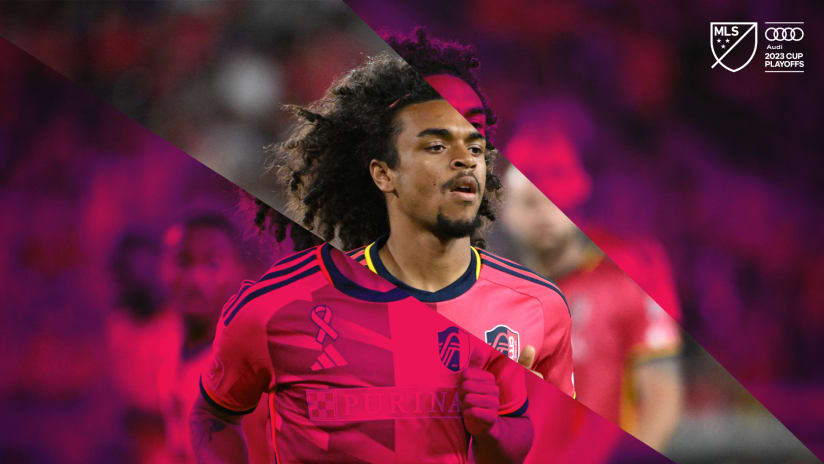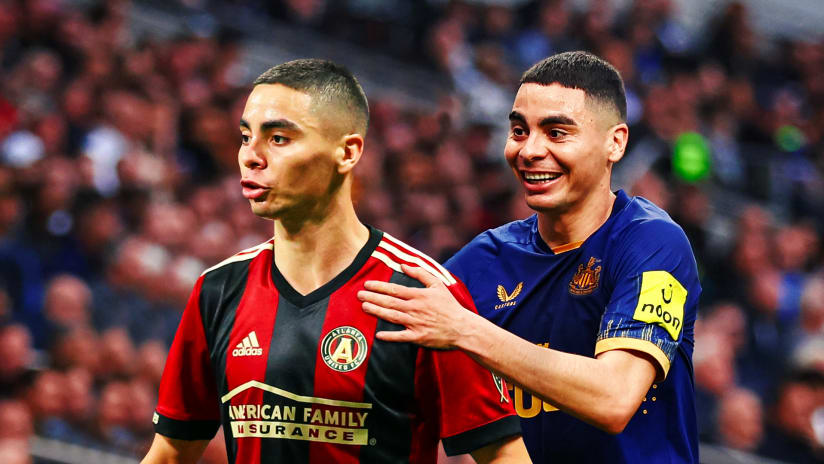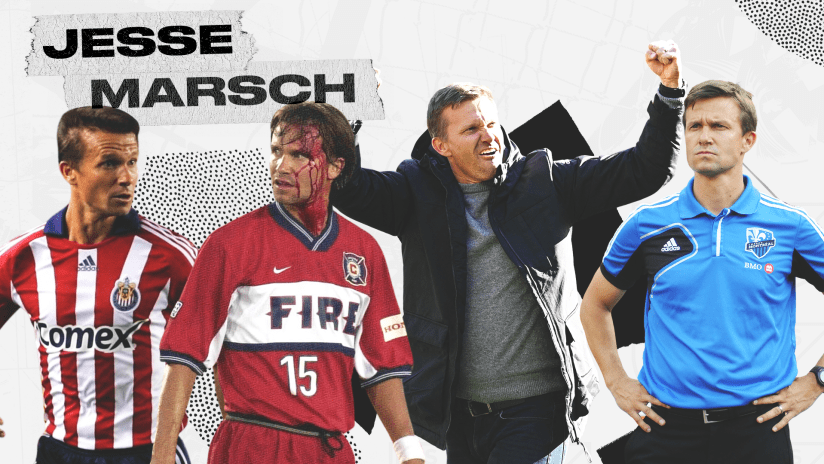ST. PAUL, Minnesota – The first thing you notice when you visit the Twin Cities is that Minnesota nice isn’t just a stereotype. People hold doors, they’re courteous and polite and everyone hopes you have a nice day.
The second thing you notice, once a conversation penetrates the surface level, is that people are deeply proud to be Minnesotans. They value their rich heritage, and the cultural diversity in the region. Dig a little deeper into the soccer community and it doesn’t take long to figure out they feel the same about the history of the sport in their state.
They grew up with the game and know it well. They still play, or miss the days when they could. Their children play, as do their nieces and nephews, friends and neighbors. For that, directly or indirectly, many can thank Buzz Lagos, an irrepressibly humble man who fell hard for soccer and has spent his entire adult life trying to convince anyone who’ll listen that they ought to do the same.
Buzz picked up soccer in the late 1960s from a returning Peace Corps volunteer and fellow graduate student at the University of Minnesota. He’d come to the Twin Cities from New Jersey as a runner and basketball player but quickly joined a team founded by German immigrants and turned himself into a toe-poking men’s league striker and youth soccer coach.
For decades, when few, if any, were listening in Minnesota, Buzz plugged away. In addition to raising a family of eight, including two star soccer prospects of his own (Gerard and former MLSer Manny), he organized youth clinics and high-school leagues, attracting whatever corporate support he could and sending letters to local sports writers and editors urging them to support soccer.
And when his boys hit a developmental dead zone in 1990 – the Minnesota Kicks and Strikers long since kaput – Buzz, his friends and their families became barnstormers, resurrecting professional soccer in the state from scratch.
“To me those years were like The Shawshank Redemption,” Manny says. “My father was like Andy Dufresne. He just kept banging on doors and sending letters and eventually the library got built.”
Those efforts culminate on Sunday when Minnesota United FC take the field for their first-ever MLS match in front of what’s expected to be more than 35,000 fans, a historic match against fellow expansion hopefuls Atlanta United that will be broadcast across the world (5 pm ET; ESPN | MLS LIVE in Canada). Two years from now a soccer-specific stadium, just a brisk walk down University Avenue from where Buzz raised Manny and his brothers and sisters, will open its doors to a new generation of fans.
Before the game, Manny, now Minnesota United’s sporting director, and Buzz, whose coaching brain is still firing on all cylinders well into retirement, will be honored with other prominent figures from the state’s rich soccer history. Dr. Bill McGuire and the rest of the club’s ownership group will take in the scene, the day a direct result of their decision to step in and save professional soccer in the Twin Cities. Behind the goal, long-time supporters of the club will shake their heads and wonder, “How on earth did this happen?”
What they’ll see reflected back at them on the field and in stands at TCF Bank Stadium is MLS made in Minnesota. More accurately, soccer made in Minnesota. It is the legacy of a family and community that refused to let the game fade away and in the process made it distinctly their own.

The National Sports Center Stadium in Blaine is the centerpiece of the largest amateur sports facility in the world. It hosted Minnesota Thunder, NSC Minnesota Stars and Minnesota United games over the years and will be the home of FC Minneapolis in 2017. Photo courtesy of Minnesota United FC
BEFORE MINNESOTA UNITED, BEFORE MLS SEEMED POSSIBLE, before the prospect of a gleaming new stadium came the Minnesota Thunder, the amateur team Buzz dreamed up in 1990 when Gerard, Manny and their friends, among them fellow St. Paul Academy stars Tony Sanneh and Amos Magee, needed games in between college seasons.
They were soccer wildcatters. Lagos coached, family friend Tom Engstrom, now an executive with the Charlotte Independence, was general manager and their families did the rest, selling tickets, manning the PA system and chipping in with whatever that particular day required.
Buzz sank what he could of his teacher’s salary into the venture, supplementing the team’s sparse budget with ticket sales to a handful of games each year and a few corporate sponsors. In 1995, boasting a once-in-a-lifetime generation of Minnesota-born talent, the Thunder turned professional, chugging along in one iteration or another and as part of one lower-division league or another for nearly two decades under the guidance of Buzz and eventually Magee then Manny.
It was brave. It was entrepreneurial. It was just a little bit crazy. Minnesotans could relate to the men behind the club and the players on the field. Nobody got rich, but they kept professional soccer alive in Minnesota.
“How did these things happen? Where did these guardian angels come from?” Buzz says now, thinking back on years mixed with off-field uncertainty as well as plenty of on-field success. “I’m never sure. We just happened to be in the right place to do the right things at the right time. Nothing grandiose, but we just hung in there and good things kept happening.”
Manny Lagos was a member of generation of talent that put Minnesota soccer on the map. He was a star player for the Thunder, coached by his father Buzz, before moving to MLS. After his playing days, Lagos went on to become an executive with the Thunder then head coach of the Stars and is now Minnesota United's sporting director. Photo courtesy of Minnesota United FC
Then came the financial crash, and in 2009 the money dried up. With Manny now at the helm of the club, the Thunder were surviving, but just barely. Major League Soccer? That was outside the realm of possibility, something for the Seattles, Portlands and Vancouvers of the world to chase. The Thunder needed to pay their bills, and they needed investors who could carry the club into the future, if there was one at all.
“We took a lot of pride in paying players on time,” Manny says. “There were very few times we missed paychecks or pay periods, but it happened a few times. It hit the club hard.”
So hard that the National Sports Center, where the team played its home games, had to step in ahead of the 2010 season, renaming the club the NSC Minnesota Stars and completing a single season before USSF regulations forced the NASL to take over operations until a new owner could be found. The search dragged on for nearly two years, and the franchise faced a deadline. Find a new owner, or cease to exist.
Professional soccer in Minnesota needed a lifeline. It would get one from a man who knew almost nothing about the game other than it needed saving.
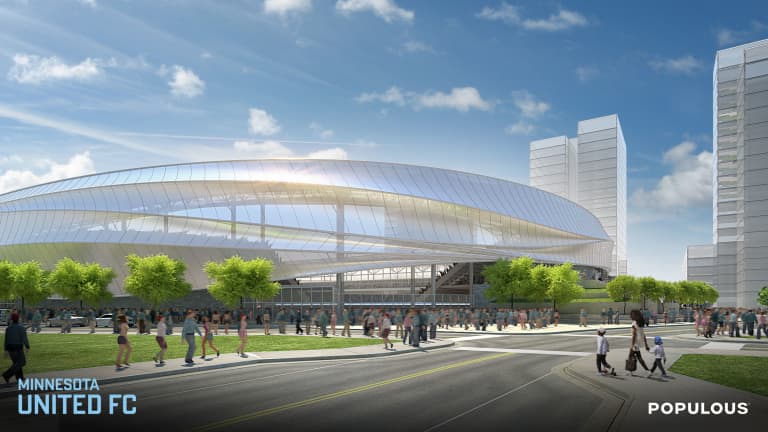
Minnesota United's stadium in St. Paul's Midway neighborhood will seat 19,916 fans. Ground was broken on the privately funded $150 million facility in December and it is scheduled to be ready for the 2019 season. Photo courtesy of Minnesota United FC
IT DOESN'T LOOK LIKE MUCH NOW, a dusty lot flanked by big-box stores just off I-94, but this is the future home of professional soccer in the Twin Cities, conveniently nestled in the Midway neighborhood nearly equidistant between the dueling downtowns of St. Paul and Minneapolis.
But soon, from this nondescript parcel of ground, a cathedral to the game, slated to open ahead of the 2019 season, will rise. It will represent a brick-and-mortar permanence that Minnesota soccer fans have craved for decades, a $150 million investment in the future of the game.
Dr. Bill McGuire, the longtime CEO of UnitedHealth Group and more recently owner of Minnesota United, is intimately familiar with just about every aspect of the design. He ought to be, the building is largely his brainchild.
In truth, even McGuire is a little bit shocked that he’s in this position. He knew next to nothing about soccer when then NASL Commissioner David Downs called in the fall of 2012, one year after McGuire had blown off his initial Hail-Mary attempt, and convinced him to attend a Minnesota Stars playoff game.
McGuire, an ardent basketball fan and sports enthusiast, hadn’t known there was a professional soccer team in the Twin Cities before Downs reached out in 2011. But as he sat in the stands at the NSC Stadium in Blaine, where 4,642 fans cheered the Stars as they ran out to a 2-0 lead against the Tampa Bay Rowdies in the first leg of the Soccer Bowl, NASL’s championship series, McGuire fell in love.
When the final whistle blew, the Dark Clouds popped smoke bombs and nearly broke down the fence celebrating a win made even bigger by the fact that the club’s future was in very much in doubt. Kids milled around on the field. The players triumphantly made the rounds, shaking hands and signing autographs for anyone who wanted one.
McGuire didn’t know much about the sport, but he walked away knowing Minnesota needed a professional team.
“It was very much seeing it live,” he says. “That was an emotional thing: ‘Wow, how can we not have this and still say we are a diverse, international city? All the great international cities have soccer.’ Our culture reflects that international side. We’re very progressive, and we don’t have the world’s sport? That’d just be nuts.”
So, a little more than a week after the Rowdies came back and pipped the Stars to the championship, McGuire bought the team. And then he set about learning everything he could about soccer.
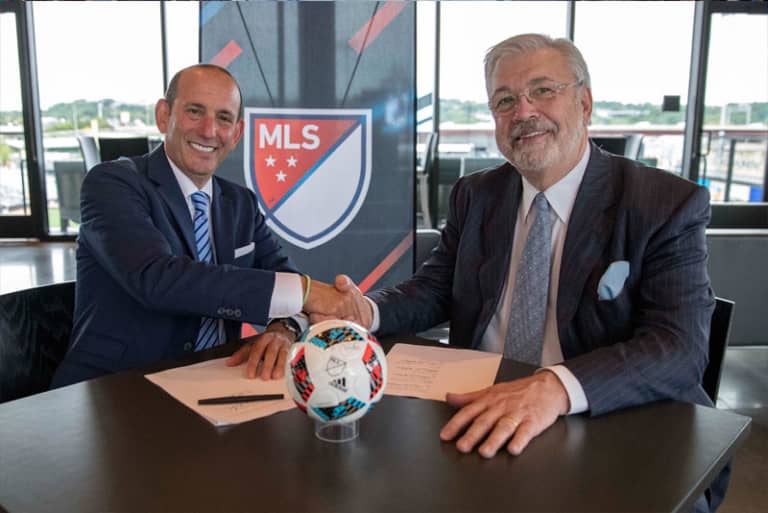
MLS Commissioner Don Garber (left) and Minnesota United owner Dr. Bill McGuire shake hands after signing an expansion agreement that made the Loons the latest club to join Major League Soccer. USA TODAY Sports Images
These days, McGuire watches every match he can on television, pays close attention to the player market and is voracious in his pursuit of soccer knowledge, often drawing sporting director Manny Lagos into long tactical discussions. He spends most days at the Minnesota United offices preparing for the club’s inaugural MLS season and guiding the construction process at the Midway site. His investment is sizeable, and it extends far beyond finances.
Don’t look for him in the luxury boxes on Sunday. McGuire says he’ll sit, as he often does, with the supporters. He’ll have a couple beers, and do his best to keep his competitive juices under control as Minnesota United look for their first-ever MLS victory a week after losing 5-1 in Portland, a result that will have undoubtedly rankled McGuire all week.
“My wife doesn’t even like to sit around me during games,” he says.
Results are important, to be sure, but for McGuire and the rest of the local consortium, which includes Minnesota Twins owners Robert and Jim Pohlad and Minnesota Timberwolves owner Glen Taylor among others, the team represents more than just a competitive venture and long-term investment. To them, Minnesota United and the stadium being built are community assets, akin to an art museum or public park.
Same for the modern training facility and academy digs currently under construction at the National Sports Center in Blaine, where thousands of youth players will mingle with the professionals as they go about their daily work. Same for the academy, still in its infancy, which will provide opportunity for those who strive to emulate their heroes and play in MLS.
In Minnesota and the Twin Cities, McGuire sees a reflection of the world. He sees people proud of where they’re from and proud of where they’re going. He sees diversity – vibrant Somali, Hmong and Spanish-speaking communities, in particular – and a cosmopolitan, progressive approach to life that might surprise those who’ve never made the trip north.
Just as he did on that October evening in 2012 when the fate of the club and the city changed forever, McGuire sees an opportunity to give back to the people who made him fall in love with soccer in the first place.
“The fans, I would argue more than any other sport, are part of soccer, part of the competition. You can see it,” he says. “There is that intensity. There is that passion. There is that connection and community. We need to always remember that, just like the players on the field, the people that are in the stands are an integral part of the club.”

The Dark Clouds serenade Minnesota United players after an NASL game at the NSC Stadium. Photo courtesy of Minnesota United FC
IT'S AN UNSEASONABLY WARM WEEKEND IN LATE FEBRUARY, so it’s no surprise when more than 40 people show up at Currie Park in Minneapolis’ West Bank to play pickup soccer on a Saturday morning.
Adam Jarvi, an architect with a soft first touch and stocking cap that doesn’t want to stay on his head, had no problem getting a permit from the city for the field. The turf is normally covered in snow this time of year. Jarvi’s Twitter blast from the night before draws a cross section of Minnesota soccer fans to a field abutting a playground where Somali children from the neighborhood play while their mothers chat on their cell phones.
Jarvi is a member of the Dark Clouds and plenty of his friends from the Minnesota United supporters’ section show up, along with their more boisterous cousins, True North Elite, leadership from the local American Outlaws chapter and a good chunk of unaffiliated folks who just want to play. Many sport Loons gear purchased the night before at the team’s jersey launch party, held at a trendy warehouse space across the river from downtown Minneapolis.
The game is good-natured and a little bit sloppy. That’s to be expected. It’s been a long winter of waiting. Waiting for the snow to melt and the fields to clear, of course, but also for what spring would bring: first-division outdoor soccer in the Twin Cities for the first time since the Minnesota Kicks’ ill-fated final year in 1981.
“We’ll see if I sleep the day before the opening match,” says Nicholas Bisbee, a founding member and capo in True North Elite who plays goalkeeper, shows off a Loon tattoo on his arm and was among the more than 150 supporters who made the trip to see United take on the Timbers last Friday on opening day. “I don’t know if I can put into words how excited I am. Portland lit a fire in my stomach.”
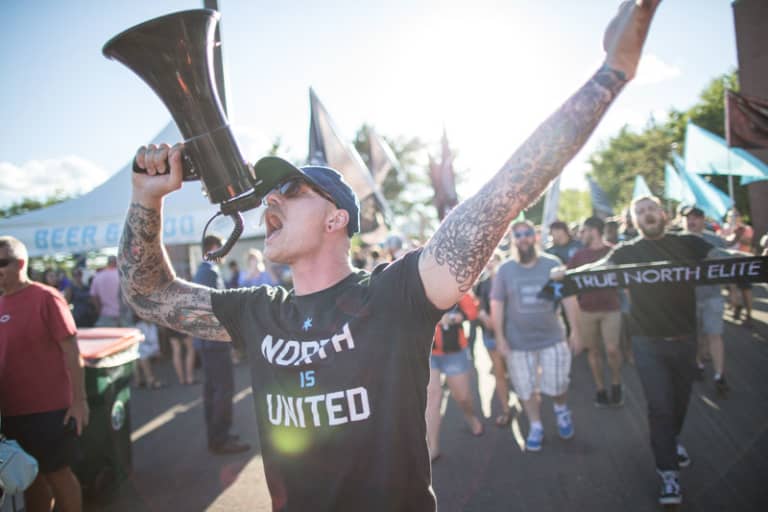
Nicholas Bisbee (pictured) and friends founded True North Elite after a trip to Seattle to watch a Cascadia Derby match. The group has grown to nearly 200 members and will make their voices heard on Sunday when Minnesota United play their first-ever MLS home game at TCF Bank Stadium. Photo courtesy of Minnesota United FC
True North Elite are the new kids in town, inspired by a trip to Seattle that Bisbee and his buddy Mykel Hosek took in April 2015 to check out a Cascadia Derby match. The Sounders defeated the Timbers 1-0 on that day, but it was what happened in the bars, streets and stands before, during and after the match that caught the pair’s attention.
They marched with the Emerald City Supporters. They hung out with Timbers Army and experienced an away day. By the time they got back to the Twin Cities, they’d decided they wanted to start their own supporters group, one that would provide an alternative to the Dark Clouds, Minnesota’s original supporters group, for those who preferred a more aggressive style.
TNE started with five members and were just nine deep the first time they took their place together at the NSC Stadium in Blaine. They waved pirate flags and made as much of a ruckus as they could but, in Bisbee’s words, “it was pretty small potatoes.”
It’s not small potatoes anymore. The group is closing in on 200 members and bring a hard edge to Minnesota United’s supporters’ section. And while they aim to intimidate and don’t apologize for their intensity and sometimes colorful language, Bisbee says True North Elite draws an even harder line at discrimination of any kind: no racism, no homophobia, no sexism and no violence.
Those are tenets the Dark Clouds, by far Minnesota United’s largest and most well-known independent group with more than 1,000 members, can get behind, even if they prefer a slightly less in-your-face style of support.
Bruce McGuire (no relation to Dr. Bill McGuire), a mainstay on both the Minnesota and national soccer scenes, remembers when fans of the then Thunder, many of them strangers, began gathering in the same spot near the visitor’s bench at James Griffin Stadium in St. Paul during the 2004 season. The group quickly coalesced, and cultivated a penchant for creative and unconventional heckling, songs and oftentimes bizarre behavior that became a staple of the group’s approach to the gameday experience.
From there, in addition to their own nontraditional brand of tifo displays, the Dark Clouds branched out into absurdity, non sequiturs and, as McGuire puts it, just being “flat out weird.”
“Our impetus was to be the opposite of ultras. We’d see that on television and we’d kind of snicker. We thought it was kind of funny,” McGuire recalls. “We thought, ‘Well, we’re certainly not that. We’re not badasses, that’s for sure. We’re kind of dorks, so let’s pick a name that could be for the ultras.’ It’s like a spoof name. That was the beauty of it, why we enjoyed it so much. It was a put on.”
The Dark Clouds still don’t take themselves too seriously, but there’s no doubt they’re the dominant force among Minnesota United’s supporters more than a decade after their founding. The group’s growth is nothing short of remarkable, up more than 1,300 percent in five years to 1,000 paying members, per president Jim Oliver, numbers that help fund season-to-season operations as well as an active charitable arm.

A member of the Dark Clouds supports the team in costume at a Minnesota United game. The group takes pride in being "flat out weird," according to founding member Bruce McGuire. Photo courtesy of Minnesota United FC
Thanks to their history, membership base and long-standing relationship with the club, the Dark Clouds have assumed a leading role organizing and supporting other nascent groups in the section. With that, there’s a recognition that a broader base will require a more mainstream approach at times. That’s fine and in many ways necessary, says Oliver, as long as it doesn’t compromise the group’s creative culture and originality, what’s become a distinctly Minnesotan style of support after more than a decade and numerous iterations of the team.
Still, there’s some uncertainty baked into Sunday’s MLS home opener for the Dark Clouds, True North Elite and every other fan who walks through the gates.
Nobody, the club included, knows quite what to expect from the atmosphere at TCF Bank Stadium. As long as they help provide a true home-field advantage for their Loons, perhaps with some assistance from the elements, that’ll be enough on what will be an emotional day for those just finding their identity as supporters as well as those who’ve been there from the start.
“I’m going to walk through that stadium door and cry, I guarantee it,” Oliver says. “Even though [TCF Bank Stadium] is temporary, Sunday at home is going to be the brass ring. Whatever happens in the game, the fact that it’s even happening is going to be a big deal.”
Sunday’s match will be among coldest in MLS history. Forecasts call for a high of 28 degrees and perhaps even snow flurries, conditions likely to be jarring for Atlanta United and their sizeable South American contingent. For the Loons and their fans, though, it’ll be just another early spring day. It’s Minnesota, after all.
“I think we’re at 70 percent chance of snow, and that would be a dream come true for me,” Bisbee says. “One of our songs is, ‘We come from the cold and frozen North,’ and I think that would be very fitting.”
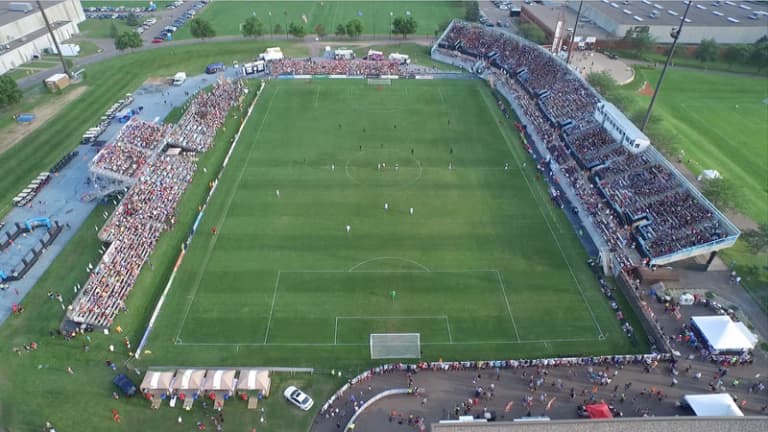
Though Minnesota United will no longer play league games at NSC Stadium, they could return for US Open Cup matches. They are also building a training facility at the National Sports Center, where the academy will be based as well. Photo courtesy of Minnesota United FC
THE BUILDING SMELLS EXACTLY AS YOU'D EXPECT. A distinct mustiness settles into your nostrils when you walk through the front doors, years of accumulated sweat distilling into an aroma that’s complimented by the scent of nacho cheese and doughy pretzels from the concession stand.
On this Sunday, not far from ongoing construction on the club’s training facility, there’s a 4-v-4 youth tournament taking place at the National Sports Center in Blaine, where the Thunder, Stars and then United played for many years. Parents in folding chairs watch from the sidelines, while bored siblings find ways to entertain themselves just outside the field of play. It’s a scene that’s played out here hundreds of times over the years.
Jen Banken’s son Brenden plays for Blaine Soccer Club. He’s 11 years old, almost 12, a fifth grader with a shock of blonde hair who “has played ever since he could walk.” A former radiology technologist, Banken changed her career path after getting involved with the club and is now one of seven full-time employees.
There’s plenty to do. Blaine Soccer Club comprised about 600 players in 2002. Fifteen years later, they’re up to more than 3,100, around 900 on travel teams and 2,300 playing recreationally. And that’s just a drop in the bucket. All told, there are nearly 80,000 registered youth soccer players in Minnesota, and plenty more playing informally.
Every kid in the gym knows about Minnesota United FC. Most have been part of a club night, walking out on to the field with the team or taking in the action in the stands alongside their teammates. It’s not all hot dogs, sodas and autograph opportunities, either. At BSC, the kids are required to submit a written report after the match, detailing what they learned from watching their professional positional counterpart.
“They get to know the players,” Banken says. “They have idols they can look at and learn from. We have the potential to get some really good players out of Minnesota.”
Brenden’s team loses in the semifinals, avoiding a matchup with St. Paul United, a team made up primarily of players from the Twin Cities’ sizeable Hmong community, the first generation of which arrived in Minnesota in the 1970s following the Vietnam War.
In the final, SPU put on a clinic, much to the delight of the cadre of parents and grandparents. Their touches are clean and their off-the-ball movement and defensive pressing creates scoring opportunity after scoring opportunity. They win easily, effortlessly stringing together passes and raising eyebrows among the other parents.
It’s a small club, assistant coach Tee Lee says, and about 80 percent of the players are Hmong. Many come from low-income families, but they’re serious about player development and train up to five times a week, heading indoors in the winter to stay sharp, in addition to playing in tournaments and league matches.
“We can’t keep them off the field,” Lee says.
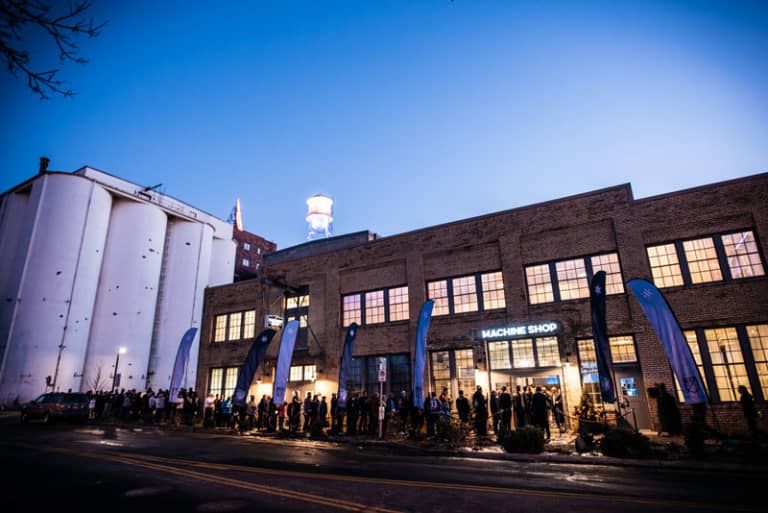
A line of supporters forms outside Minnesota United's jersey launch.Photo courtesy of Minnesota United FC
There’s plenty of talent in the gym, and even if these kids don’t make it all the way to MLS – Minnesota United launched U-13 and U-14 academy teams this year, with plans for more age groups later – the legions of youth players in the metro area and beyond will help define soccer culture in the Twin Cities and form the core of Minnesota United’s fanbase for decades to come.
They are the beneficiaries of the work done by Buzz Lagos and many others, whose love for the game helped create an exploding youth scene that’s turned the Twin Cities into a hub for soccer. They have Dr. Bill McGuire and his ownership group to thank for a first-division team and world-class cathedral to the game. And in the stands, they’ll see (and perhaps join one day) the Dark Clouds, True North Elite and others supporting the Loons in a way they can identify with, one that’s distinctively Minnesotan.
They are the present and future of soccer in Minnesota, both of which, after years of uncertainty, are increasingly bright.
“It comes back to this community. We’re unique. We’re on an island,” Manny Lagos says. “We take a lot of pride in how we go about life and how we live here. We’re very proud of that. We are the North, and I love that line. If soccer can be an extension of that pride and how we present ourselves globally, we can be one of the better clubs in the world, right here in Minnesota.”
THE WORD is MLSsoccer.com's regular long-form series focusing on the biggest topics and most intriguing personalities in North American soccer. Check out THE WORD archive.


